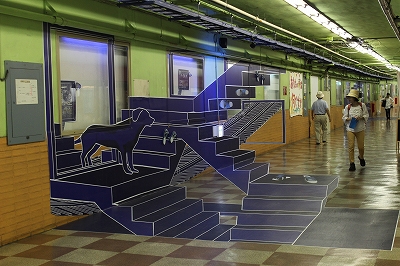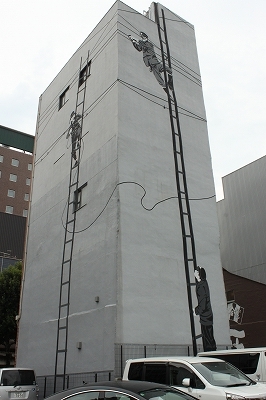Aichi Triennale, a City-type Art Festival in Japan
Inside Look at Aichi Triennale
There are many different art festivals in Japan. The most famous one is probably the Triennale in Naoshima. It attracts many tourists from Japan and abroad. Naoshima is an island in the Seto Inland Sea, and its scenic beauty is one of the best things about it, but there are also art festivals held in cities. This is the city's version of an art festival.
In 2019 there was a big triennale art festival in Japan. Nagoya, one of Japan’s three major cities with a population of around two million, observes the holding of the Aichi Triennale, with venues scattered in and around the metropolis.

Like Setouchi, the festival marks its second time. This year’s venue has been expanded to include the neighboring city of Okazaki, where Tokugawa Ieyasu (1543-1616), one of feudal Japan’s most important political and military leaders, was born. In sharp variance with tranquil Setouchi, however, Nagoya, while retaining some historical landmarks such as Nagoya Castle, constantly bustles with people and motor traffic. In this environment the artworks project an interesting contrast: bustle and humor. Like Setouchi, Aichi’s artworks are displayed both inside and outside. The outside ones are free to be seen by anyone. Not only tourists but ordinary business people stop to see them interestingly.
This is a so-called 3D art. When you look at it from a certain angle, it seems a real thing. A dog is coming out of the wall and the staircase is leading to the door on the wall. These artworks are drawn in the basement corridor leading to a subway station. Outside on the ground level, the staircases leading down to the path are also painted, taking attentions from passers-by. From some parking spaces, buildings next to them are painted. They are not graffiti but real works of art. The title is “Looking at 2016 from 1952.” It depicts how old electricians work to repair the lines back then.

More blatant and realistic 3D art is also presented. An abandoned bowling alley demonstrates this artwork. Every two minutes, a bowling lane with 10 pins first mechanically extends from the old building and then returns. The passers-by always stop and look at this amusing artwork. The creator hopes that it will make people feel nostalgic, yet it’s presented in a humorous manner.
Arts are not only limited to inanimate objects, but include performing arts such as dancing and singing. Using concert halls, outdoor city squares or on the streets, both famous and amateur performers present their acts. Outside performances are free to be seen and can quite easily get the audience at any time. That’s a good thing for an urban art festival.
“Last time in 2010, we received about 570,000 visitors,” said Aichi Prefecture’s governor Hideaki Ohmura, who added that this year he also hopes to welcome “more than 500,000.” That figure, however, is based only on admission ticket sales, and if those who viewed the artworks displayed out of doors are included, the number would be considerably higher. Aichi Triennale 2016 is open until October 27.
Background of Aichi Triennale
The Aichi triennale’s objective differs somewhat from the one in Setouchi. By bringing progressive art to streets and urban spaces instead of confining them to museums, they aim to make art works more approachable, as if they were seamless extensions of everyday life. What’s more, this year’s theme reflects the March 11, 2011 catastrophe. Taro Igarashi, artistic director of Aichi Triennale explained: “The theme of this year’s Triennale, ‘Awakening – Where Are We Standing? – Earth, Memory and Resurrection,’ refers to the aftermath of the Great East Japan Earthquake. The theme was chosen because contemporary art is a product of its age, reflecting social trends, and also because we thought that it is important for this triennale --- an international urban art festival that will receive global attention --- to directly confront a major catastrophe that still affects our nation.”
A Tool for Rural Revitalization?

While Nagoya’s revitalization might not be Aichi Triennale’s specific objective, the situation is different for the art festivals held in rural areas.
“Right now the main means of revitalizing local areas has been either ‘art’ or ‘food,’” remarks art writer Chiaki Fujita who explains that art is utilized to focus attention on depopulated rural districts.
The first such rural Triennale organized in Japan was the Echigo Tsumari Triennale in 2000. This rural area in Niigata Prefecture is famous for its heavy snows in winter, but the region also boasts beautiful rice paddies and forests. The area’s remoteness from cities, however, has been a factor in depopulation, as seen by its many abandoned houses and closed schools. To revitalize the area, organizers came up with the idea of an art festival. In 2012, they commemorated the 5th Triennale, which attracted around 490,000 visitors to this small town of about 30,000.
The movement subsequently spread throughout Japan. Next year Yokohama will host 5th of its kind; Oita Prefecture hosted the second Triennale art festival, called, “Mixed Onsen World” in 2012.
The reason for their popularity Fujita explains, “If the festival is held in a rural area, there will be other elements to attract tourists --- onsen (mineral hot springs), food, friendly local people and so on.” So the whole rural economies can be stimulated through an art festival. The July, 2016 marked a record number of overseas visitors to Japan in a month, with over one million arrivals. For those foreign tourists, a Triennale, especially one held in a rural area, would serve as an ideal place to discover Japan’s hidden appeal.


.jpg)
One thought on “Aichi Triennale, a City-type Art Festival in Japan”